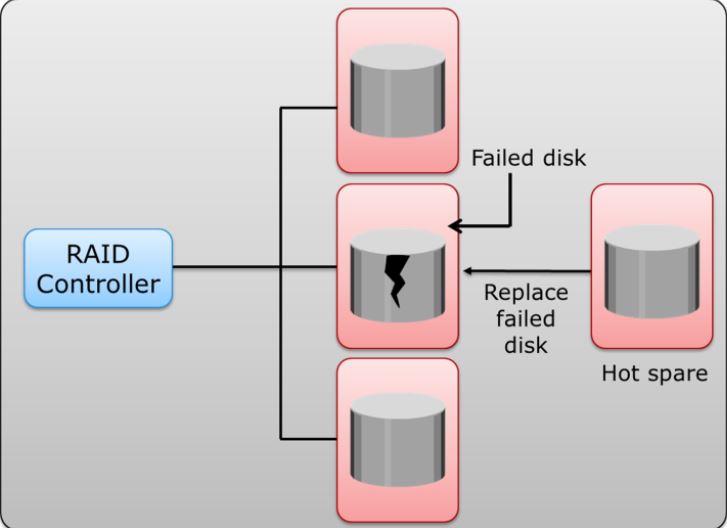The ability to perform maintenance and upgrades without interrupting operations is critical for network systems. This is where “Hot” technologies come into play, offering solutions that ensure system reliability and uptime. Among these, “Hot Spare” systems stand out for their ability to provide immediate backup functionality. Understanding these technologies is crucial for professionals managing fault-tolerant systems, redundant power supplies, and modular network infrastructure.
Jump to:
- What is Hot Spare?
- Applications of Hot Spare Systems
- Working Mechanism of Hot Spare Systems
- Comparing Hot Spare, Hot Rebuild, and Hot Swap Systems
- Advancements and Trends in Hot Spare Technology
- Conclusion
- References

1. What is Hot Spare?
A Hot Spare refers to a backup component, typically found in hardware systems like RAID arrays or network devices, that remains idle until a primary component fails. Unlike traditional backup systems that require a shutdown for replacement or repair, a Hot Spare automatically takes over the function of the failed component, ensuring continuous system operation.
The term HOT is an adjective referring to actions that can be performed on systems or hardware devices while the power for the device is still turned on or while the device still has a live network connection or telecommunications link.
2. Applications of Hot Spare Systems
“Hot” technologies are used in:
- Fault-tolerant disk drive systems such as RAID systems
- Redundant power supply systems
- Modular Ethernet switches and routers
- Redundant high-speed data communication links
Examples of disk storage systems that use “hot” technologies include the following:
- Hot-rebuild system: A drive subsystem that can automatically rebuild its original drive configuration after drive failure
- Hot-spare system: A drive subsystem that has additional unused drives that can be called into action when drive failure occurs
- Hot-swap system: A drive subsystem in which drives are mounted on trays and can be removed and replaced without shutting down the system

TIP
When you buy a hardware RAID unit, be sure that it has hot-rebuild, hot-spare, and hot-swap capabilities.
3. Working Mechanism of Hot Spare Systems
The working mechanism of Hot Spare systems is a critical component in ensuring high availability and reliability in various technological infrastructures. Here’s a more detailed look into how these systems function:
- Standby Mode: In a Hot Spare setup, one or more spare components (such as hard drives in a RAID array) are kept in a standby mode. They are connected and ready to be used, but they don’t actively participate in the system’s operations under normal conditions.
- Monitoring and Detection: The system continuously monitors the health and performance of active components. This monitoring can be based on various parameters like performance metrics, error rates, or other failure indicators.
- Automatic Failover: Upon detecting a failure in an active component, the system automatically initiates a failover process. This process involves the Hot Spare component stepping in to take over the role of the failed component.
- Synchronization: Once the Hot Spare is activated, it synchronizes with the current system state. In the case of data storage, this might involve data mirroring or rebuilding the data array to include the Hot Spare.
- Seamless Operation Continuation: The goal of this mechanism is to ensure that the system continues to operate seamlessly, with minimal or no downtime. End-users or services typically do not experience any disruption during this transition.
4. Comparing Hot Spare, Hot Rebuild, and Hot Swap Systems
Understanding the differences and similarities between Hot Spare, Hot Rebuild, and Hot Swap systems is crucial for effective system design and management:
- Hot Spare Systems:
- Function: Act as a standby component ready to take over immediately in case of a primary component failure.
- Use Case: Ideal for critical systems where uptime is paramount, such as in RAID configurations or network equipment.
- Hot Rebuild Systems:
- Function: Automatically rebuild the original configuration or data array after a component failure. This process often works in tandem with a Hot Spare.
- Use Case: Commonly used in RAID systems where data integrity and continuity are critical. The rebuild process restores the RAID array to its full redundancy after a disk failure.
- Hot Swap Systems:
- Function: Allow for the physical replacement of a component (like a hard drive or power supply) without needing to power down the system.
- Use Case: Useful in environments where maintenance or upgrades need to be performed without disrupting operations. It offers more flexibility compared to Hot Spare systems but requires manual intervention.
Differences and Application Context
- Instantaneity: Hot Spare offers immediate failover, while Hot Rebuild involves a restoration process that might take time.
- Manual Intervention: Hot Swap requires manual replacement of components, unlike the automated nature of Hot Spare and Hot Rebuild.
- System Downtime: Both Hot Spare and Hot Rebuild aim to minimize downtime, which can be a concern during a Hot Swap process if not managed efficiently.
In summary, while all three systems aim to enhance system reliability and reduce downtime, they differ in their approach and application contexts. Understanding these nuances is essential for IT professionals and system administrators to choose the right solution for their specific needs.
5. Advancements and Trends in Hot Spare Technology
The realm of Hot Spare technology is continuously evolving, driven by the need for enhanced system reliability and efficiency. Here’s a look at some of the latest advancements and emerging trends:
- Integration with Cloud and IoT: As cloud computing and IoT (Internet of Things) become more prevalent, Hot Spare technology is being adapted to work seamlessly with these platforms. This integration allows for more flexible and scalable redundancy solutions, especially in distributed and cloud-based systems.
- AI-Driven Predictive Analysis: Artificial Intelligence (AI) is being employed to predict potential system failures before they occur. By analyzing data patterns and performance metrics, AI can identify when a component is likely to fail and automatically activate a Hot Spare, thus preventing downtime.
- Advancements in Storage Technology: In data storage, Hot Spare technology is benefiting from advancements in solid-state drives (SSDs) and NVMe (Non-Volatile Memory Express) technology. These technologies offer faster data transfer rates and improved reliability, making them ideal for Hot Spare applications.
- Automated Management Tools: The development of sophisticated management tools is simplifying the administration of Hot Spare systems. These tools provide real-time monitoring and automated maintenance capabilities, enhancing overall system resilience.
- Energy-Efficient Hot Spare Solutions: There’s a growing focus on energy efficiency in Hot Spare systems, particularly in data centers. New technologies are emerging that reduce the power consumption of standby components, contributing to more sustainable IT operations.
6. Conclusion
Hot Spare technology represents a vital aspect of modern computing and networking systems, offering a seamless way to maintain continuous operations. Its role in ensuring system reliability and reducing downtime is invaluable, especially in environments where system availability is critical. Understanding and effectively implementing Hot Spare systems is a key competency for IT professionals in today’s technology landscape.
7. References
- “High Availability and Disaster Recovery: Concepts, Design, Implementation” by Klaus Schmidt.
- “Cloud Computing: Concepts, Technology & Architecture” by Thomas Erl, Ricardo Puttini, and Zaigham Mahmood.
- “Artificial Intelligence for Autonomous Networks” by Mazin Gilbert, Jorgen Ericsson.
- “Dual modular redundancy“, (Wikipedia, Nov 2023)